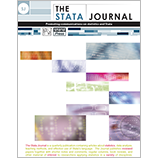Simulation-based sample-size calculation for designing new clinical trials and diagnostic test accuracy studies to update an existing meta-analysis
Michael J. Crowther
Department of Health Sciences
University of Leicester
Leicester, UK
[email protected]
|
Sally R. Hinchliffe
Department of Health Sciences
University of Leicester
Leicester, UK
|
Alison Donald
Department of Health Sciences
University of Leicester
Leicester, UK
|
Alex J. Sutton
Department of Health Sciences
University of Leicester
Leicester, UK
|
Abstract. In this article, we describe a suite of commands that enable the user
to estimate the probability that the conclusions of a meta-analysis will change
with the inclusion of a new study, as described previously by Sutton et al. (2007,
Statistics in Medicine 26: 2479–2500). Using the metasim command, we take a simulation
approach to estimating the effects in future studies. The method assumes
that the effect sizes of future studies are consistent with those observed previously,
as represented by the current meta-analysis. Two-arm randomized controlled trials
and studies of diagnostic test accuracy are considered for a variety of outcome
measures. Calculations are possible under both fixed- and random-effects assumptions,
and several approaches to inference, including statistical significance and
limits of clinical significance, are possible. Calculations for specific sample sizes
can be conducted (by using metapow). Plots, akin to traditional power curves, can
be produced (by using metapowplot) to indicate the probability that a new study
will change inferences for a range of sample sizes. Finally, plots of the simulation
results are overlaid on extended funnel plots by using extfunnel, described in
Crowther, Langan, and Sutton (2012, Stata Journal 12: 605–622), which can help
to intuitively explain the results of such calculations of sample size. We hope the
command will be useful to trialists who want to assess the potential impact new
trials will have on the overall evidence base and to meta-analysts who want to
assess the robustness of the current meta-analysis to the inclusion of future data.
View all articles by these authors:
Michael J. Crowther, Sally R. Hinchliffe, Alison Donald, Alex J. Sutton
View all articles with these keywords:
metasim, metapow, metapowplot, meta-analysis, diagnostic test, sample size, evidence-based medicine
Download citation: BibTeX RIS
Download citation and abstract: BibTeX RIS
|
